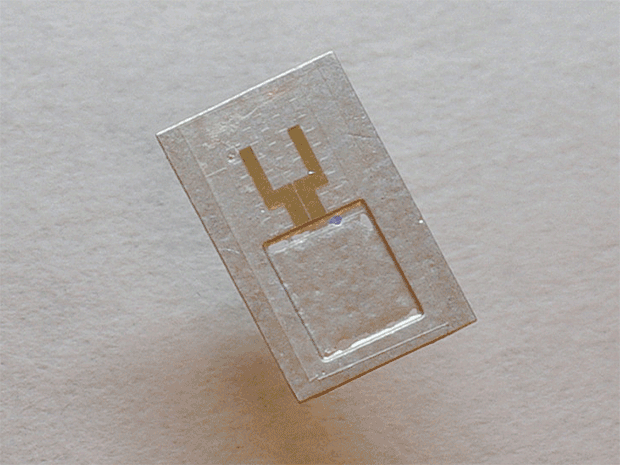Sensors Slip into the Brain, Then Dissolve When the Job Is D
Source: Tekla S. Perry
 Photo: John Rogers/University of Illionis at Urbana-Champaign
Photo: John Rogers/University of Illionis at Urbana-Champaign
Five days. That’s how long intracranial pressure and temperature typically need to be monitored in the case of traumatic brain injury. And that’s at least how long flexible, dissolvable sensors created by a research team at the University of Illinois led by professor John Rogers will operate accurately.
I met Rogers a year ago, interested in the temporary tattoos and other flexible electronics patches he’d been developing that were designed to be so similar to the skin that you could wear them for days without noticing them. Though the majority of his scientists and engineers were involved in making sensors and transmitters as stretchable as his lab’s serpentine silicon circuits, Rogers clearly had his eye on the horizon. In particular, he was after electronics structures that could be implanted seamlessly in the brain or on or around other organs. These sensing, communicating devices would need to have new geometries and new properties to fit in with the complex structures of the body without compromising them. [For the full story see “A Temporary Tattoo That Senses Through Your Skin”.]
Today, Rogers released news of his latest breakthrough in silicon biocompatible circuitry: pressure and temperature monitors, intended to be implanted in the brain, that completely dissolve within a few weeks. The news, published as a research letter in the journal Nature, described a demonstration of the devices in rats, using soluble wires to transmit the signals, as well as the demonstration of a wireless version, though the data transmission circuit, at this point, is not completely resorbable.
The technology, the Nature letter reports, can be adapted to sense fluid flow, motion, pH, and other parameters, and could be implanted in the heart, other organs, or in the skin.
The team at the University of Illinois built what are essentially microelectromechanical systems (MEMS) out of a membrane of polylactic-co-glycolic acid, a biodegradable polymer common in medical applications such as dissolvable stitches. This membrane sits on a substrate of nanoporous silicon or a metal foil. The foil is etched with trenches that create an air cavity, allowing the membrane to deflect in response to pressure changes in the surrounding fluid. A piezoresistive element constructed from Rogers’ classic stretchable serpentine coils detects the changes. The structure is stable for at least five days, but completely dissolves after three weeks in the body. Rogers expects the neurosurgeons at Washington University in St. Louis who are testing the device in rats to move into more extensive studies with larger animals; human trials could begin in perhaps five years.
Meanwhile, Rogers hopes to continue to improve the technology, pushing its useful life to four weeks before the devices are significantly resorbed.
But next up for Rogers and his team: resorbable devices that go beyond sensing to actively help in treatment. For example, Rogers hopes to build a resorbable device that could electrically stimulate damaged nerves to accelerate the healing, as well as programmable devices that could release timed doses of drugs.
| }
|